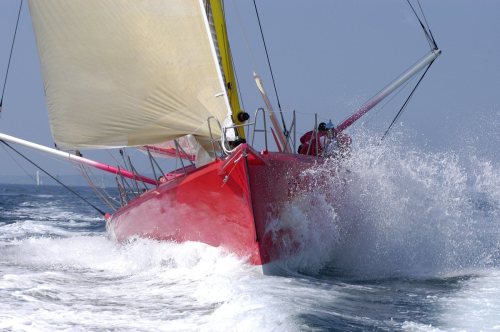


High performance composites have undoubtedly won their place in applications requiring a combination of low weight with high performance but, to really hit the jackpot, these combination materials must be able to be processed faster and less expensively than they currently are.
The advent of pre-impregnated fibre materials (prepregs) has helped, by sidestepping lengthy manual wet lay-up processes that were once the norm – as well as improving quality and consistency. Consequently, the focus has shifted to the cure side of the overall process and, in particular, to avoiding the use of autoclaves. Acquiring and operating large autoclaves is very costly and their finite capacities create process bottlenecks. Hence out-of-autoclave (OoA) processes able to speed up fabrication and reduce costs whilst also equalling autoclave quality have become a holy grail in composite circles.
| In a nutshell, the requirement is for prepregs that are curable at low-temperature and low-pressure to yield a high-quality result. |
Alternatives to autoclaving include vacuum bag, matched moulding, tube rolling and pressure bag processes. Of these, vacuum bagging is the most prevalent so much attention is directed at improving this process. The goal is to produce a material system that can deliver high laminate quality when cured in an oven or on heated tooling, under vacuum-induced consolidation pressure of one atmosphere (max.) rather than the up to 10 atmospheres (bar) a typical autoclave can exert. In a nutshell, the requirement is for prepregs that are curable at low-temperature and low-pressure to yield a high-quality result.
Historically, early attempts to process barely modified autoclave prepregs in ovens were unsuccessful and engineers resorted to greater resin manipulation in developing materials that would cure successfully at lower temperatures, in general below 100°C. Laminates produced from these first-generation OoA prepregs were of modest quality suitable for prototyping and cheap tooling rather than for primary structure. However, OoA systems developed since the early 2000s offer high void-free quality that are comparable with autoclave processed equivalents.
According to Bryan Louis from the Department of Mechanical and Process Engineering at the Swiss Federal Institute of Technology, Zurich, this minimum voidage aspect is a leading issue. He relates that it took some years for material manufacturers to work out the mechanics of air and gas entrapment and how to expel these unwanted elements from a vacuum processed in-cure laminate. It became clear that, in contrast to autoclave processing, where void reduction is achieved by using pressure to force entrapped air and volatiles into solution during gelation, OoA methods must expel these elements under much lower pressure (i.e. atmospheric) prior to gelation. This requires ‘breathable’ prepregs and resin that remains porous to air for sufficient time before gelling. Consequently, tailoring resin rheology for vacuum extraction of the gases is critical.
The physical make-up of the material is also important. Developers have addressed material architectures in various ways, for instance including air pathways by only partially pre-impregnating the base fibre mat. Initial dry regions thereby left in this ‘partial prepreg’ become impregnated only as the cure proceeds.
Pioneer
One company that has done much to further the cause of OoA prepreg processing is Umeco’s Advanced Composites Group. ACG recognised that developing matrices capable of being cured at temperatures below autoclave levels (typically 180°C) would be key to autoclave avoidance, enabling affordable low-tech (relatively) ovens or heated tooling to be used instead. However, the trick was to accomplish this with the minimum loss of properties in the cured product.
ACG was a pioneer with its Low Temperature Moulding (LTM®) prepregs that were used in several important aircraft programmes including American X-Series prototypes, notably the Boeing X45A and X34 and Northrop Grumman’s X47A unmanned combat aerial vehicle (UCAV). LTM prepregs are curable at temperatures down to 40°C and, provided the initial cure is subsequently followed by a post cure, Tg values of up to 180°C can be achieved in the final laminate. LTMs are also used for automotive body panels, racing yacht structures, wind turbine blades, tooling and infrastructure. A third-generation LTM material, LTM310, makes a good tooling prepreg suitable for OoA curing, whereas first and second-generation LTMs normally require an autoclave cure where tooling is the intended application. Maximum service temperature for LTM310 is 180°C, despite initial cure at just 65-70°C.
Senior Applied R&D Engineer David Bashford asserts that other OoA-processable prepregs developed by the company are now providing levels of quality acceptable to the aerospace community as witnessed, for example, by their use in Airbus secondary wing panel sets for the Airbus A350 XWB airliner now in development. Aerospace fabricators favour ACG’s Medium Temperature Moulding (MTM®) prepregs, curing at around 90°C. MTM45-1, for instance, is a second-generation toughened epoxy system which, when cured initially at this temperature and subsequently post cured, provides a Tg (dry) of 185°C. This material has been used for fabricating the Virgin Galactic/Scaled Composites Spaceship 2 and White Knight 2 spacecraft combination, claimed to be the world’s largest OoA-cured aerospace structure. Void content of less than 0.5% has been achieved in similar cured laminates.
Another product is the company’s Variable Temperature Moulding (VTM®) series, suitable for OoA curing at between 65°C and 120°C. A feature of this prepreg family is extended outlife (21-28 days at 21°C), a valuable feature when fabricating large structures. This is proving a boon in constructing high-performance ocean racing and cruising yachts where freedom from autoclave dependence has facilitated the fabrication of large, high-quality hull and deck structures cured in modular extendable ovens. Team Alinghi’s 2003 America’s Cup challenger helped set the tone by utilising VTM264 unidirectional carbon fibre-epoxy prepreg. VTM materials are also used for body panels of limited-edition supercars, and in road bridge support beams.
Bashford cites potential OoA advantages as reduced capital expenditure through autoclave avoidance, energy savings, increased manufacturing rates, production flexibility, ability to manufacture very large structures, reduced core crush and core stabilisation problems in sandwich panels, and use of lower-cost tooling. Even so, much of the need for OoA processing, he tells Reinforced Plastics, is driven by the accelerating use of composites expected over the next decade. In aerospace alone, a large backlog of passenger jets already ordered will be augmented by a new-generation of fuel efficient aircraft now in conceptual and early design stages, while wind energy, marine and automotive sectors are all likely to hike their demands for composites.
“Given the expected 10-15% compound growth expected in composites usage,” Bashford declares, “there just won’t be enough autoclaves in the world to meet the processing demand. Capital expenditure would be impossibly high and there would be an autoclave round every corner.”
Interestingly, Umeco Structural Materials is in the process of being acquired by US concern Cytec Engineered Materials, another pioneer of OoA technology. By the middle of the last decade Cytec was achieving properties close to those of autoclave prepregs with its CYCOM 5215 material. However, working outlife was considered insufficient by the US aerospace and defence communities for laying up large, complex structures. Cytec responded with its CYCOM 5320 series, offering an open-mould life of at least 30 days. CYCOM 5320 OoA material has been extensively evaluated in US demonstrator programmes and has been selected by Bombardier Aerospace for the wings and fuselage of its lastest business jet, the Learjet 85.
This article was published in the September/October 2012 issue of Reinforced Plastics magazine © 2012 Elsevier Ltd. All rights reserved.
The digital edition of Reinforced Plastics is distributed free of charge to readers who meet our qualifying criteria. You can apply to receive your free copy by completing the registration form.






